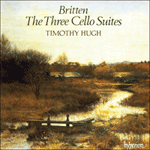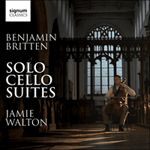The First Suite appeared to be such an exhaustive compendium of both compositional and string-playing techniques that it was something of a surprise when the composer produced a companion piece in August 1967. The Suite No 2 was given its first performance by Rostropovich at the 1968 Aldeburgh Festival, and is similar in layout to its predecessor (although lacking the recurrent Canto which had bound the earlier work together). An introductory Declamato (Largo) leads to a complex Fuga (Andante), in which Britten’s monophonic counterpoint is so ingenious that the fugue’s subject can be presented in up to three dovetailed entries without recourse to double-stopping. Next comes a Scherzo (Allegro molto) which presents two contrasting ideas and later combines them in a condensed form. A slow movement (Andante lento), exploiting a tonally ambiguous alternation between major and minor triads, leads without a break into the concluding Ciaccona (Allegro) where Britten indulges in his favourite ground-bass form with characteristic inventiveness and fluency.
from notes by Mervyn Cooke © 2013
La première suite semblait être un condensé si exhaustif des techniques d’écriture et de jeu des instruments à cordes que ce fut une surprise de voir le compositeur lui donner un pendant en août 1967. La Suite nº 2 fut créée par Rostropovitch au Festival d’Aldeburgh en 1968 et suit le même plan que la précédente (mais sans le Canto récurrent qui servait de lien dans l’œuvre antérieure). Un Declamato (Largo) introductif mène à une Fuga (Andante) complexe, où le contrepoint monophonique de Britten est si ingénieux que le sujet de la fugue peut être présenté dans au moins trois entrées qui concordent sans avoir recours aux doubles cordes. Vient ensuite un Scherzo (Allegro molto) avec deux idées contrastées réunies ensuite sous une forme condensée. Un mouvement lent (Andante lento), exploitant une alternance ambiguë sur le plan tonal entre accords parfaits majeurs et mineurs, mène sans interruption à la Ciaccona (Allegro) conclusive où Britten se laisse tenter par sa forme préférée (la ground-bass) avec un esprit d’invention et une aisance caractéristiques.
extrait des notes rédigées par Mervyn Cooke © 2013
Français: Marie-Stella Pâris
Die Erste Suite schien ein so erschöpfendes Kompendium sowohl an kompositorischen als auch Streicher-Techniken, dass es relativ überraschend war, als der Komponist im August 1967 ein weiteres derartiges Werk vorlegte. Die Suite Nr. 2 wurde erstmals beim Aldeburgh Festival 1968 von Rostropowitsch aufgeführt und ist in der Anlage ähnlich wie das Vorgängerwerk (obwohl der wiederkehrende Canto, der das frühere Werk zusammenhielt, hier fehlt). Ein einleitendes Declamato (Largo) leitet in eine komplexe Fuga (Andante) hinein, in der Brittens monophoner Kontrapunkt so genial gesetzt ist, dass das Fugenthema in bis zu drei sich überlagernden Einsätzen präsentiert werden kann, ohne dass Doppelgriffe nötig sind. Als nächstes kommt ein Scherzo (Allegro molto), in dem zwei unterschiedliche Ideen vorgestellt werden, die dann später in verdichteter Form kombiniert sind. Ein langsamer Satz (Andante lento), in dem ein tonal mehrdeutiges Alternieren zwischen Dur- und Molldreiklängen stattfindet, leitet ohne Pause in die abschließende Ciaccona (Allegro) hinein, in der Britten seiner Lieblingsform, dem Basso ostinato, mit charakteristischer Erfindungsgabe und Flüssigkeit frönt.
aus dem Begleittext von Mervyn Cooke © 2013
Deutsch: Viola Scheffel

 Britten: Cello Suites
Britten: Cello Suites Britten: Cello Suites
Britten: Cello Suites
